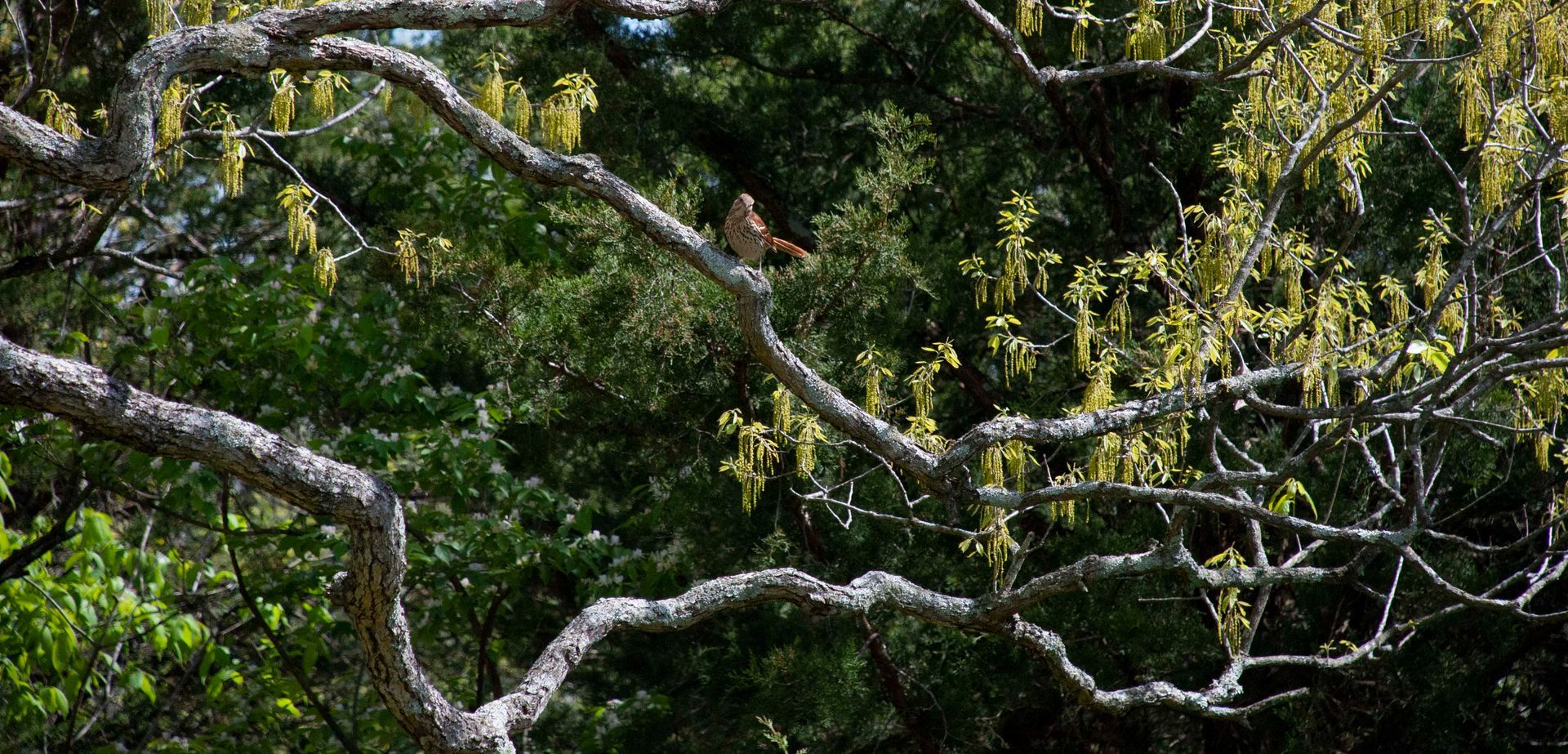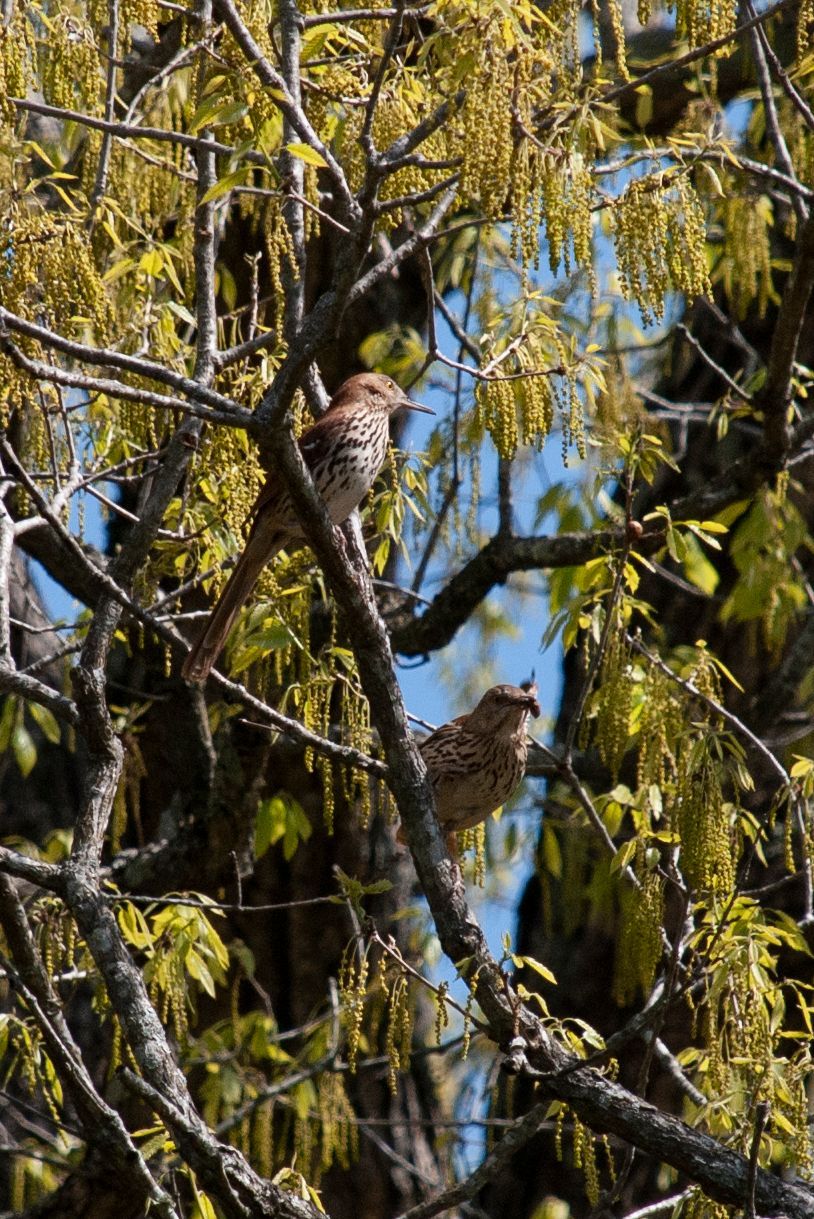Following her brief encounters at the Grandmother Tree, Karen Lanier wondered, "What could I learn by really listening to the brown thrasher?"
My almost-daily practice of observing birds for a few minutes, during a lunch break or a slow walk through the park, rewards me with something new every day. An odd character that caught my attention might seem ordinary to some observers, and looks like a mix between a robin and a mockingbird. The brown thrasher, Toxostoma rufum, is not quite as common as either of these. The genus name Toxostoma means arched or bowed mouth. The species name rufum refers to the reddish color of this noisy bird. Noisy, for a few reasons: thrashing, smacking and singing.
I first heard it thrashing. Its long, curved bill sweeps and probes in the shady undergrowth, searching through dead leaf litter. Next, I noticed its rusty-hued, long wings and tail, and the drop-shaped spots scattered on its chest. It had a proud look for a ground scrounger.

Later, I heard it again, and found the brown thrasher in a more dignified posture. This time, a noise was coming from above, surrounding me with smacking sounds as I walked close to the chinquapin oak affectionately known as “The Grandmother Tree.” I braced myself against the nearby Heart Bench sculpture (by Kate Clark). From there, I hoped to give the bird enough space, as I leaned back and zoomed in with my binoculars. I wasn’t sure if it was sending me a warning call or alerting its companions of my presence. Pretty soon, I noticed a second thrasher in the tree too, holding a small prize delicately but firmly in its beak. Maybe a beetle, or a caterpillar, or a moth?
It could have been any of these. Oaks host a multitude of life forms. The nature writer Doug Tallamy, who promotes creating a widespread
“homegrown national park” – wildlife habitats nurtured by everyone in their backyards – has declared
oak trees to be the most important plants in North America. Its leaves are the food source for hundreds, maybe thousands, of caterpillars – nature’s best bird baby food, soft and squishy and full of protein.
The realization that I might be causing a hungry bird couple some distress motivated me to move along and leave them in peace. If they are a mated pair, they will build their nest together and share all parental duties equally. They seemed to be kissing me goodbye with the smacking that followed me down the trail.

Recalling the first sight of the thrasher in the thicket, it has a mockingbird’s silhouette, and they are in the same family of mimics. No wonder its song was hard to identify, as I probably had heard it singing and assumed I was listening to its cousin. But the brown thrasher holds the record for the richest and most complex repertoire in North America. Sources report between 1,100 and 2,000 different thrasher songs and sounds. How can we tell the difference between a thrasher’s song and a mockingbird’s? It’s in the rhythm. Mockingbirds generally repeat a phrase 3 or more times, while thrashers repeat it just twice. Here’s an example of what their songs can sound like: “plant a seed, plant a seed, bury it, bury it, cover it up, cover it up, let it grow, let it grow, pull it up, pull it up, eat it, eat it.” (Listen to the brown thrasher's song albums here.)
Following my brief encounters, I wondered, other than puzzling over their complicated songs, what could I learn by really listening to the brown thrasher?
My first clue, hearing them foraging for food on the forest floor, opens up a world of ecological connections between this bird and land conservation here at JSP. Thrashers are omnivores and some of their biggest meals include grubs, worms, beetles, and other soil-dwelling bugs. Among the insects they eat, some are considered destructive if their populations aren’t kept under control, including army and tent caterpillars, cut worms, gypsy moth caterpillars, and grasshoppers.
Thrashers also depend on the protection of bushes and shrubs, dense thickets and thorny brambles, which is part of the reason I’m not familiar with this bird. Modern landscaping hasn’t shown much love for anything that’s not grass, a flower or a tree. Most backyards aren’t built out of thorns, and thrashers aren’t likely to show up at a bird feeder. But reforestation and regenerative landscaping includes all layers. Some of the thorniest plants also provide this bird’s (and probably everyone’s) favorite summertime food - berries. Thrashers feast on everything from blackberries to holly.
Brown thrashers may not be the most famous birds promoting the conservation of diverse forests, but they can teach us not to overlook the beauty of life in the shadows. Little is known about their mating habits because of their secluded and inaccessible (to humans) habitat. Will the pair I saw in the oak tree still be together this time next year? Hopefully we’ll have even more diverse forest understory to help them thrive, and we’ll be listening for their thrashing, smacking and melodies.
About the Author
Karen Lanier is a teaching artist, environmental educator and nature writer who also serves as Josephine Sculpture Park’s Administrative Assistant.





